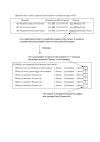Behavioral factors to include in guidelines for lifelong oral healthiness: an observational study in Japanese adults
- PMID: 17181853
- PMCID: PMC1769481
- DOI: 10.1186/1472-6831-6-15
Behavioral factors to include in guidelines for lifelong oral healthiness: an observational study in Japanese adults
Abstract
Background: The aim of this study was to determine which behavioral factors to include in guidelines for the Japanese public to achieve an acceptable level of oral healthiness. The objective was to determine the relationship between oral health related behaviors and symptoms related to oral disease and tooth loss in a Japanese adult community.
Methods: Oral health status and lifestyle were investigated in 777 people aged 20 years and older (390 men and 387 women). Subjects were asked to complete a postal questionnaire concerning past diet and lifestyle. The completed questionnaires were collected when they had health examinations. The 15 questions included their preference for sweets, how many between-meal snacks they usually had per day, smoking and drinking habits, presence of oral symptoms, and attitudes towards dental visits. Participants were asked about their behaviors at different stages of their life. The oral health examinations included examination of the oral cavity and teeth performed by dentists using WHO criteria. Odds ratios were calculated for all subjects, all 10 year age groups, and for subjects 30 years or older, 40 years or older, 50 years or older, and 60 years or older.
Results: Frequency of tooth brushing (OR = 3.98), having your own toothbrush (OR = 2.11), smoking (OR = 2.71) and bleeding gums (OR = 2.03) were significantly associated with number of retained teeth in males. Frequency of between-meal snacks was strongly associated with number of retained teeth in females (OR = 4.67). Having some hobbies (OR = 2.97), having a family dentist (OR = 2.34) and consulting a dentist as soon as symptoms occurred (OR = 1.74) were significantly associated with number of retained teeth in females. Factors that were significantly associated with tooth loss in both males and females included alcohol consumption (OR = 11.96, males, OR = 3.83, females), swollen gums (OR = 1.93, males, OR = 3.04, females) and toothache (OR = 3.39, males, OR = 3.52, females).
Conclusion: Behavioral factors that were associated with tooth retention were frequency of eating snacks between meals, tooth brushing frequency, having one's own toothbrush, smoking and drinking habits, having hobbies, having a family dentist and when they had dental treatment. Clinical factors included bleeding gums, swollen gums, and toothache.
Figures
Similar articles
-
Development of an oral salutogenic checklist to promote lifelong oral health in Japanese adults.Oral Health Prev Dent. 2008;6(4):287-94. Oral Health Prev Dent. 2008. PMID: 19178093
-
[An oral health scoring system for promoting 8020 achievement in residents].Nihon Koshu Eisei Zasshi. 2000 May;47(5):421-9. Nihon Koshu Eisei Zasshi. 2000. PMID: 10860388 Japanese.
-
Oral health habits and the number of teeth present in Japanese aged 50-80 years.Community Dent Health. 1997 Dec;14(4):248-52. Community Dent Health. 1997. PMID: 9458584
-
Effectiveness of professional oral health care intervention on the oral health of residents with dementia in residential aged care facilities: a systematic review protocol.JBI Database System Rev Implement Rep. 2015 Oct;13(10):110-22. doi: 10.11124/jbisrir-2015-2330. JBI Database System Rev Implement Rep. 2015. PMID: 26571287
-
Oral health of individuals aged 3-80 years in Jönköping, Sweden during 30 years (1973-2003). I. Review of findings on dental care habits and knowledge of oral health.Swed Dent J. 2005;29(4):125-38. Swed Dent J. 2005. PMID: 16463569 Review.
Cited by
-
Category of functional tooth units in relation to the number of teeth and masticatory ability in Japanese adults.Clin Oral Investig. 2010 Feb;14(1):113-9. doi: 10.1007/s00784-009-0270-8. Epub 2009 Mar 31. Clin Oral Investig. 2010. PMID: 19333627
-
Urban-rural differences in the prevalence of having a family dentist and their association with income inequality among Japanese individuals: a cross-sectional study.BMC Oral Health. 2024 Jun 27;24(1):741. doi: 10.1186/s12903-024-04528-8. BMC Oral Health. 2024. PMID: 38937717 Free PMC article.
-
Characteristics of Individuals in Japan Who Regularly Manage Their Oral Health by Having a Family Dentist: A Nationwide Cross-Sectional Web-Based Survey.Int J Environ Res Public Health. 2022 Aug 23;19(17):10479. doi: 10.3390/ijerph191710479. Int J Environ Res Public Health. 2022. PMID: 36078196 Free PMC article.
-
Clinical and community risk models of incident tooth loss in postmenopausal women from the Buffalo Osteo Perio Study.Community Dent Oral Epidemiol. 2010 Dec;38(6):487-97. doi: 10.1111/j.1600-0528.2010.00555.x. Community Dent Oral Epidemiol. 2010. PMID: 20636416 Free PMC article.
-
Effect of commercial fluoride dentifrices against hydrochloric acid in an erosion-abrasion model.Clin Oral Investig. 2015 Jan;19(1):71-6. doi: 10.1007/s00784-014-1213-6. Epub 2014 Feb 28. Clin Oral Investig. 2015. PMID: 24578231
References
-
- Mizuno T, Nakagaki H, Murakami T, Kato K, Tsuboi S, Takigawa T, Ozawa A, Kumeno C, Ohno Y. Lifestyles related to preserving 20 or more teeth at 80 years of age. Japanese Journal of Public Health. 1993;40:189–195. - PubMed
-
- Morita I. Retained tooth numbers and history of diet and lifestyle in the elderly aged 60, 70 and 80 years. Journal of Dental Health. 1996;46:688–706.
-
- World Health Organization A review of current recommendations for the organization and administration of Community oral health services in northern and western Europe Report on a WHO workshop Oslo. 1982.
-
- Kayser AF. Shortened dental arches and oral function. J Oral Rehabil. 1981;8:457–462. - PubMed
-
- Kayser AF, Witter DJ, Spanauf AJ. Overtreatment with removable partial dentures in shortened dental arches. Aust Dent J. 1987;32:178–182. - PubMed
LinkOut - more resources
Full Text Sources
Miscellaneous


